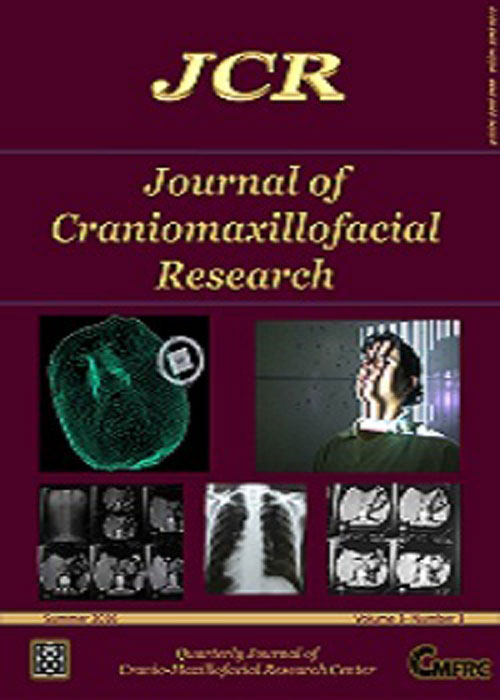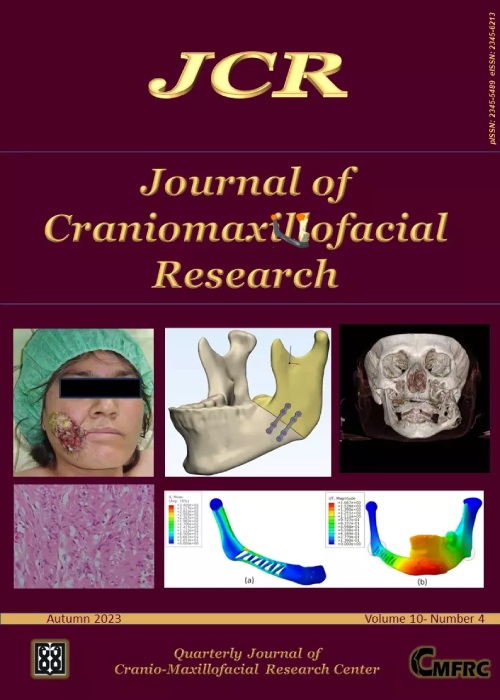فهرست مطالب

Journal of Craniomaxillofacial Research
Volume:3 Issue: 2, Spring 2016
- تاریخ انتشار: 1395/04/05
- تعداد عناوین: 5
-
-
Pages 177-184IntroductionEfforts are being made to improve the efficacy of biomaterials used as bone substitutes for bone regeneration in the oral and maxillofacial region. Graft materials have been recently produced in Iran; however, studies are required to confirm their efficacy. This study aimed to compare the histomorphometric results of using mineralized allografts produced by the Hamanandsaz Baft Kish Company and the Iranian Tissue Bank (ITB) for regeneration of rabbit calvarial bone defects.Materials And MethodsIn this animal study, four similar holes with a minimum diameter of 6.5 mm were created in the calvaria of 14 white New Zealand rabbits. The defects were filled with Cenobone (Hamanandsaz Baft Kish Co.), ITB product and Cerabone (Botiss Co). One defect remained unfilled as the control group. One and two months after implantation, the animals were sacrificed and the defects was subjected to histologic and histomorphometric assessments. The amount of new bone formation and the volume of remaining biomaterials were analyzed using one-way ANOVA. The inflammatory reaction was analyzed by the Kruskal Wallis test and the foreign body reaction, bone quality and bone-graft interface pattern were analyzed using the Fishers exact test.ResultsThe amount of new bone formation was 0.060.1± and 0.11± 0.1, 0.040.08± and 0.110.09±, and 0.080.12± and 0.090.06± mm2 in the ITB, Cerabone and Cenobone groups at one and two months post-implantation, respectively.
The effect of time and type of biomaterial on the amount of new bone formation was not significant. At one month, significant differences were seen in the amount of remaining biomaterials in the defects among the three groups (PConclusionBone allografts such as Cenobone and ITB had optimal efficacy for bone regeneration in rabbit calvarial defects comparable to that of Cerabone xenograft. Considering the limitations of in vitro studies, application of these biomaterials must be evaluated in clinical studies.Keywords: Bone formation, Cenobone, Cerabone, Calvarial defects -
Pages 185-190IntroductionPemphigus vulgaris (PV) is a relatively rare autoimmune disease characterized by blistering of the skin and mucosa. The main objective of this study was to investigate the possible association between the 5-HTTLPR polymorphism and PV in Iranian patients. For this, 112 PV and 100 controls were enrolled in this study.Materials And MethodsIn this case-control study, Genomic DNA was extracted from whole blood and genotyping of all participants for the 5-HTTLPR polymorphism was carried out using the polymerase chain reaction (PCR) technique. The genotypes were grouped into three classes: homozygous for the short allele (SS), heterozygous for the short and long allele (LS) and homozygous for the long allele (LL).ResultsOur results showed no significant association between the 5-HTTLPR polymorphism genotypes, LL, SS and LS in PV patients compared to controls. Also, our finding did not reveal any evidence of an association between this disease and the allele frequency of S and L. Taken together, our findings suggested that the 5-HTTLPR polymorphism is unlikely to be a factor contributing to the risk of developing pemphigus vulgaris.ConclusionIt can be concluded that although 5-HTTLPR polymorphism seems to be associated with some of auto-immune and stress-related disease.Keywords: Iranian Population, PCR, Pemphigus vulgaris, Polymorphism, Risk Factor
-
Pages 191-195IntroductionOpen rhinoplasty is very common now a days and the number of candidate for this type of surgery are increasing. This research was conducted regarding to the prevalence of rhinoplasty surgery , the importance of the residual scar analyze including columellar scar after surgery, different results caused by the effect of incision type in this surgery and lack of enough data and experimental report on it.Materials And MethodsThe research was conducted by COHORST STUDY plan. 120patients with indications of open rhinoplasty was selected by sampling method and located in three groups with three incision types including V, Invert V and Step incision. The surgery was done in same condition from surgical aspect and followed for 6 months. The analyze of columellar scar was investigated in three indexes of scar outbreak, notching and depression or bump in three groups by K2 test and satisfaction level of the patients was measured with VAS criteria, and was analyzed with MANN-U-WHITNEY test.ResultsThe research was conducted on 120 samples including V type of incision with 74 samples, Invert V with 33 samples and STEP incision with 13 samples. Scar formation in 25/7 %, 27/2 % and 23/8 % respectively was found (pConclusionIt seems all three incision types lead to the same result in open rhinoplasty.Keywords: Columellar scar, incision type, open rhinoplasty, patient satisfaction
-
Pages 196-201IntroductionOral health is an important aspect of public health which affects peoples quality of life. Oral health related quality of life is assessed to evaluate the effect of different diseases on individuals daily life quality. The aim of this study was to examine the oral health related quality of life in patients with head and neck tumors who received radio and chemotherapy.Materials And MethodsThis cross-sectional study was done in 2015 on the fifty patients with head and neck tumors who were referred to Babolsar Shahid Rajae hospital and Sari Emam Khomeyni hospital for radio and chemotherapy, and fifty healthy individuals as control group. In this study our measuring tool was OHIP-14 (Oral Health Impact Profile) questionnaire.ResultsOur findings showed a statistically significant difference in oral health related quality of life between healthy and patients groups (PConclusionIt seems that disease status (primary or recurrent) is an important factor in decreasing oral health related quality of life in patients with head and neck tumors.Keywords: oral related life quality, head, neck tumor, chemotherapy, radiotherapy
-
Pages 202-206Intraosseous squamous cell carcinoma is a rare type of squamous cell carcinoma that requires accurate and early diagnose which is important due to its invasive feature. This article presents a rare case report on intraosseous carcinoma in a 33-year-old patient. The case was a 33-year-old man who was referred to oral disease department of Babol College of Dentistry complaining of chin pain. In the radiographic view there was a well-defined unilacular radiolucency extended from the first molar on the right side of mandible to the opposite premolars which caused perforation. Incisional biopsy showed a destructive lesion and finally, the lesion was removed by excision and curettage.ConclusionIn the present study, accurate and early diagnose of Intraosseous squamous cell carcinoma was very important due to the young age of the patient who was under 50 years old. In addition, the large size of the lesion that has passed the midline makes this case noticeable.Keywords: Squamous cell carcinoma, intraosseous squamous cell carcinoma, intraosseous carcinoma, oral cancer, mandible


